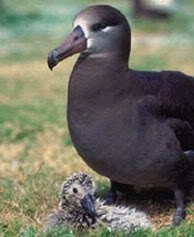Posted 08/24/2012
The U.S. Fish and Wildlife Service has issued a permit authorizing the Hawai`i longline swordfish fleet to take seabirds. The permit is the first of its kind ever issued by the agency under the Migratory Bird Treaty Act. It allows the swordfish fleet to injure or kill up to 191 black-footed albatross and 430 Laysan albatross over the three-year term of the permit.
The permit stops short of requiring the fishery to eliminate practices that, according to the American Bird Conservancy, make it more likely that birds will be snared by the fleet.
The ABC’s George Wallace, its vice president for oceans and islands, said that while the group “generally supports the issuance of permits for the Hawaiian swordfish and other U.S. fisheries as a mechanism to reduce seabird bycatch, the conditions under which this precedent-setting take permit will be issued are disappointing.”
According to the notice published August 20 in the Federal Register, the “projected take of these species in each year … and the slightly greater amount of annual take that would be authorized in a permit … would constitute less than 1 percent of the total estimated breeding population of each species each year.” As such, the take does not “contribute substantially to the cumulative total take of these seabirds estimated to occur each year in all North Pacific longline fisheries.”
Until recently, the Fish and Wildlife Service had generally deferred to the National Marine Fisheries Service, which had argued that the Migratory Bird Treaty Act did not apply to birds caught by regulated fisheries in international waters, which, NMFS claimed, lay outside the jurisdiction of the act. In 2011, NMFS reversed its position and applied for the permit.
In comments last January on a draft environmental assessment the service issued on the permit application, ABC supported an alternative that would result in limiting or reducing the current levels of mortality – and also seek compensation for unavoidable seabird mortality.
On average, 54 Laysan and 20 black-footed albatrosses are taken by the fleet each year. NMFS is not required to take any action to reduce this level of take, but it will have to analyze existing data to improve their knowledge of when and how take occurs and possible ways to mitigate that.
“One practice that could have been halted by the take permit but will be allowed to continue for now involves dragging baited hooks on the surface of the water behind the fishing vessel while other lines are retrieved. This increases the exposure of seabirds to baited hooks and leads to a higher chance of them being injured,” the ABC said.
“A remedy for this problem does not require data analysis and multiple three-year permits to develop and implement,” Wallace said. “FWS has missed an oppo



Leave a Reply